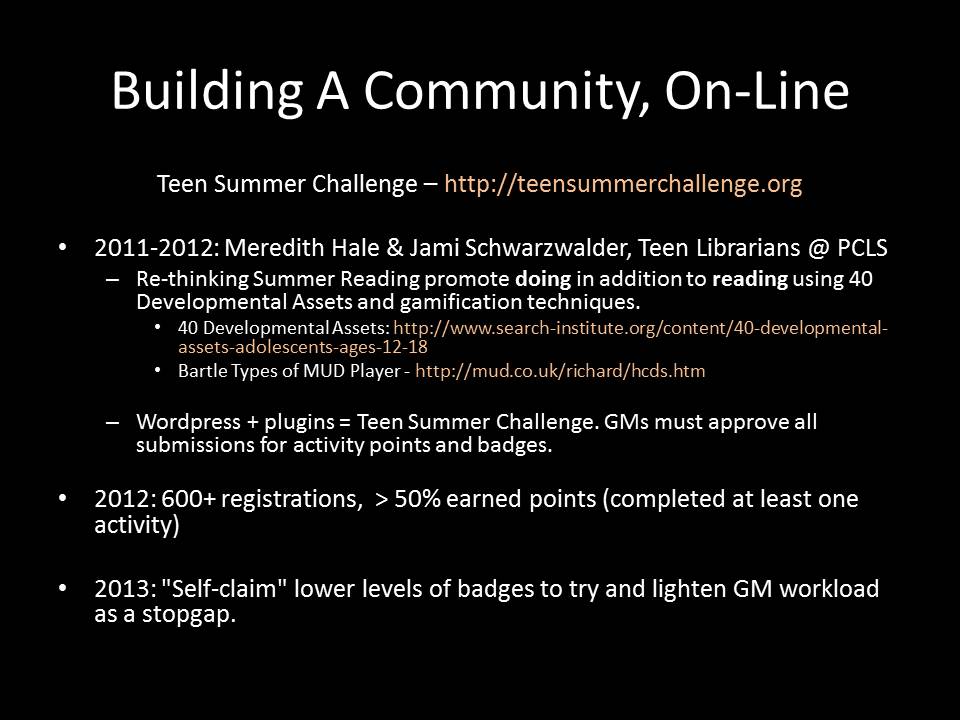Teen Summer Challenge

In addition to building infrastructure for the sharing of things and tools, the public library needs to also be able to develop infrastructure so that they can help generate community and encourage the fostering of communities that see the public library as a valuable partner and resource. This is harder than it looks, but there are some success stories to emulate.
In 2011, Pierce County Library System (PCLS) embarked on a radical re-thinking of the teen summer reading program. A program that was solely focused on books and accumulation of reading time for rewards wasn't reaching a whole lot of teens – the numbers were workable enough that the library system could hide behind this or that statistic to make it seem less of a failure, but a clear minority of people were the ones making up the majority of the recorded reading time. Rather than trying to promote books to teenagers (and there were always lots of good books to promote), the teen librarians at the time, Meredith Hale (@ladyluck131) and Jami Schwarzwalder, took the Search Institute's 40 Developmental Assets and paired them up with a new trend just emerging onto the World Wide Web - gamification. In gamification, activities that were normally just activities became wrapped in a game-like environment, adding points, badges, achievements, social elements, and more to produce a more game-like experience. As a guide, Meredith and Jami used Bartle's four types of MUD player, first released in 1996 (proving that librarians know how to make the old new again quite well), and given a more modern-looking form as the Bartle Test of Gamer Psychology to try and incorporate elements to the game that would appear to a diverse range of players.
Their conclusion was to discard the idea of reading (in its myriad forms) as the single defining thing for a summer program, and so reading became one of many activities and experiences laid out for teens in what is branded the Teen Summer Challenge. The challenge itself was spun out to a Wordpress installation, using mostly off-the-shelf plug-in components like BuddyPress to build the achievements, activities, leaderboards, and social spaces that would comprise the challenge, augmented where affordable through contact with the developers of those plugins and occasional commissioned code. The first year of the Challenge, 2012, did quite well in terms of participation (600+ registrations, of which a little over 50% performed an action to earn points) compared to the previous year's reading-only program (a little over 100 participants). Feedback was generally positive, and there was a lot of learning experience about building and running a community for the teen librarians and their supporting staff, dubbed the Grand Master Committee (GMC). (A fuller write-up of Teen Summer Challenge is available as a chapter in Teen Games Rule! A Librarian's Guide To Programs And Platforms) Since Teen Summer Challenge only officially runs during the school break in summer, if you want to observe the platform during a live session, you'll have to visit then.
The success of Teen Summer Challenge ensured a repeat performance in 2013 with better administration and tools in place to deal with the influx of material that had to be approved by the GMC to distribute points and badges. Initially, all activities for points and badges had to be approved by the The GMC. The committee understood, however, that increased participation would mean increased workload, and there would be a point in the process where it became unsustainable for the GMC to continue approving activities in its present form. Either more staff would have to be added to the GM group, or the platform and program would have to be re-worked again. The second year introduced the ability for players to "self-claim" the lower-level badges as a way of lightening the workload on the GMs. As a stopgap measure, this decision was effective, but the problem of scale still loomed large in the distance. Without some answer to that question, Teen Summer Challenge would continue to consume more staff time until it collapsed under its own weight.